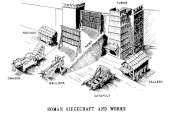Siege engine

A siege engine is a
Siege engines are fairly large constructions – from the size of a small house to a large building. From antiquity up to the development of gunpowder, they were made largely of wood, using rope or leather to help bind them, possibly with a few pieces of metal at key stress points. They could launch simple projectiles using natural materials to build up force by tension, torsion, or, in the case of trebuchets, human power or counterweights coupled with mechanical advantage. With the development of gunpowder and improved metallurgy, bombards and later heavy artillery became the primary siege engines.
Collectively, siege engines or artillery together with the necessary
Antiquity
Ancient Assyria through the Roman Empire

The earliest siege engines appear to be simple movable roofed towers used for cover to advance to the defenders' walls in conjunction with
The first Mediterranean people to use advanced siege machinery were the
The first two rulers to make use of siege engines to a large extent were

The
The first documented occurrence of ancient siege engine pieces in Europe was the
Ancient China
The earliest documented occurrence of ancient siege-artillery pieces in China was the levered principled traction catapult and an 8 ft (2.4 m) high siege crossbow from the Mozi (Mo Jing), a Mohist text written at about the 4th – 3rd century BC by followers of Mozi who founded the Mohist school of thought during the late Spring and Autumn period and the early Warring States period. Much of what we now know of the siege technology of the time comes from Books 14 and 15 (Chapters 52 to 71) on Siege Warfare from the Mo Jing. Recorded and preserved on bamboo strips, much of the text is now extremely corrupted. However, despite the heavy fragmentation, Mohist diligence and attention to details which set Mo Jing apart from other works ensured that the highly descriptive details of the workings of mechanical devices like Cloud Ladders, Rotating Arcuballistas and Levered Catapults, records of siege techniques and usage of siege weaponry can still be found today.[7]
Elephant
Middle Ages

A typical military confrontation in medieval times was for one side to lay siege to an opponent's castle. When properly defended, they had the choice whether to assault the castle directly or to starve the people out by blocking food deliveries, or to employ war machines specifically designed to destroy or circumvent castle defenses. Defending soldiers also used trebuchets and catapults as a defensive advantage.
Other tactics included
Modern era


With the advent of
The development of specialized siege artillery, as distinct from field artillery, culminated during World War I and World War II. During the First World War, huge siege guns such as Big Bertha were designed to see use against the modern fortresses of the day. The apex of siege artillery was reached with the German Schwerer Gustav gun, a huge 80 cm (31 in) caliber railway gun, built during early World War II. Schwerer Gustav was initially intended to be used for breaching the French Maginot Line of fortifications, but was not finished in time and (as a sign of the times) the Maginot Line was circumvented by rapid mechanized forces instead of breached in a head-on assault. The long time it took to deploy and move the modern siege guns made them vulnerable to air attack and it also made them unsuited to the rapid troop movements of modern warfare.
See also
References
- ^ "Siege train" Archived 2017-09-04 at the Wayback Machine on Answers.com
- ^ a b "Siege warfare in ancient Egypt". Tour Egypt. Retrieved 23 May 2020.
- ISBN 978-97-74-24600-5.
- ^ "The Catapult: A History", Tracy Rihall, 2007
- ^ An obsolete English synonym for "pluteus" is "plute"."plute". Oxford English Dictionary (Online ed.). Oxford University Press. (Subscription or participating institution membership required.)
- ^ a b c Cartwright, Mark (24 June 2016). "Roman Siege Warfare". World History Encyclopedia. Retrieved 19 January 2018.
- ^ Liang, Jieming (2006). Chinese Siege Warfare: Mechanical Artillery & Siege Weapons of Antiquity, pp. Appendix D
Sources
- Campbell, Duncan B. (2003). Greek and Roman Siege Machinery 399 BC – AD 363. Osprey Publishing.
- Liang, Jieming (2006). Chinese Siege Warfare: Mechanical Artillery & Siege Weapons of Antiquity. Leong Kit Meng. ISBN 981-05-5380-3.
